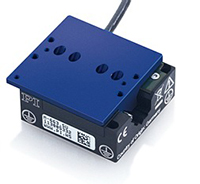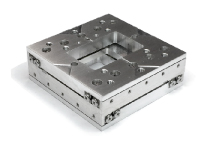Piezo motors rely on piezo materials, which are ceramics that change shape when an electrical field is applied, to produce vibrations that cause motion—either linear or rotary. (Conversely, piezo materials can also produce electricity when mechanically loaded.) There are several principles on which piezo motors can operate, with the most common of these being the use of ultrasonic vibrations, the stick-slip effect (also called inertial piezo motors), or stepping, which involves combining multiple piezo elements to get a “walking” motion.
For most engineers and designers, when they think of piezo motors, the benefits that first come to mind are small size and high resolution. But piezo motors also have a significant power-to-size ratio, providing very high torque or force for their compact dimensions. This makes them well-suited for aerospace and consumer goods applications, where high forces are needed but space is at a premium. Because of their low inertia, piezo motors exhibit very fast response times, allowing for rapid starts and stops. Piezo motors are also self-locking in a power-off condition, and can hold position without drifting, unlike servo motors, which continually “hunt” for position.
Environments that rule out other technologies are generally no problem for piezo motors. For example, piezos can operate in vacuum environments, which are common in semiconductor and electronics manufacturing equipment. In addition, ultrasonic and stepping piezo motors are nonmagnetic and can operate in strong magnetic fields, such as MRI machines. Other applications that are well-suited for piezo motors include aerospace components, optical inspection equipment, and medical devices.
As well as the benefits discussed above, each piezo motor technology has its own unique performance advantages. Ultrasonic piezo motors can achieve speeds up to 1 m/s and resolutions up to 50 nanometers. Stepping piezo motors have virtually unlimited travel length and can achieve picometer resolution via a principle called dithering. Inertial piezo motors are typically the most compact option and are available at a low-cost.

Image credit: Physik Instrumente
Piezo actuators (not to be confused with piezo motors) generally move via expansion or contraction of the piezo material in direct proportion to applied voltage. High force and fast response allow piezo actuators to replace solenoids in valves, pumps, and dispensing equipment. Piezo stages, which incorporate cross roller bearings or miniature linear guides, provide high resolution and the ability to carry heavy loads, all in a compact package. Stages can also be stacked to provide X-Y or X-Y-Z motion.The only technology able to compete with the resolution and repeatability of piezo stages are air bearings. And while air bearing stages are able to travel longer lengths, they are arguably, more complex to integrate and operate.

Image credit: Micronix USA
In applications that require micrometer or even nanometer-level resolution, piezo motors offer an unmatched combination of miniature size, long stroke length, high speed, and high force. Their resolution and repeatability rival air bearings, which also makes them a good choice for single- and multi-axis linear stage configurations. And while piezo motors have been used in industrial applications for nearly four decades, they have been traditionally regarded as too expensive for all but the most extreme requirements. However, advances in piezo materials and manufacturing methods, as well as more cost-effective controls, have brought the cost of piezo motors and actuators to a level that is competitive with other solutions.


Leave a Reply
You must be logged in to post a comment.